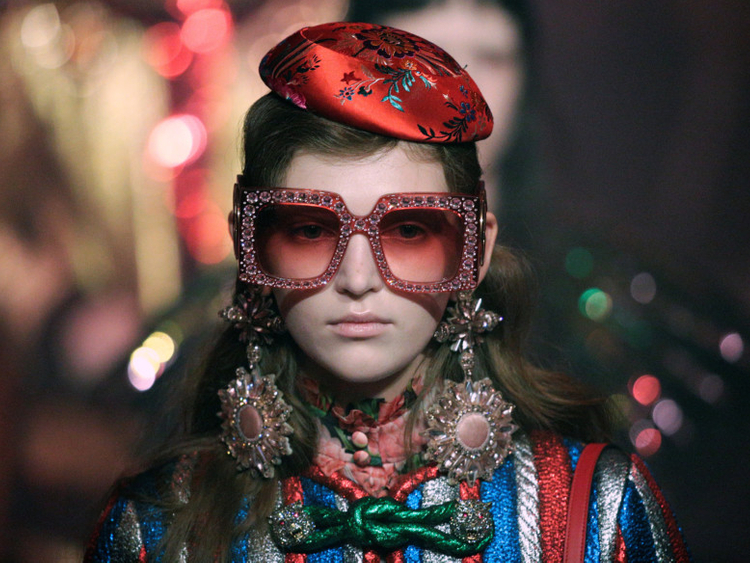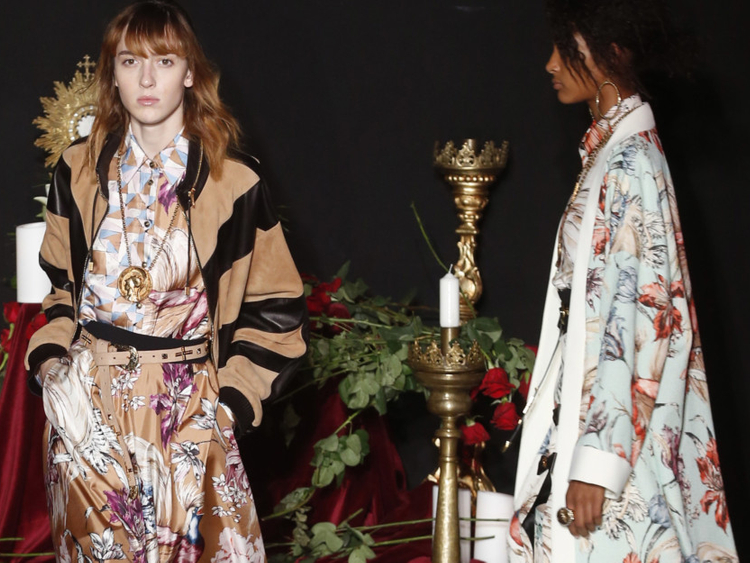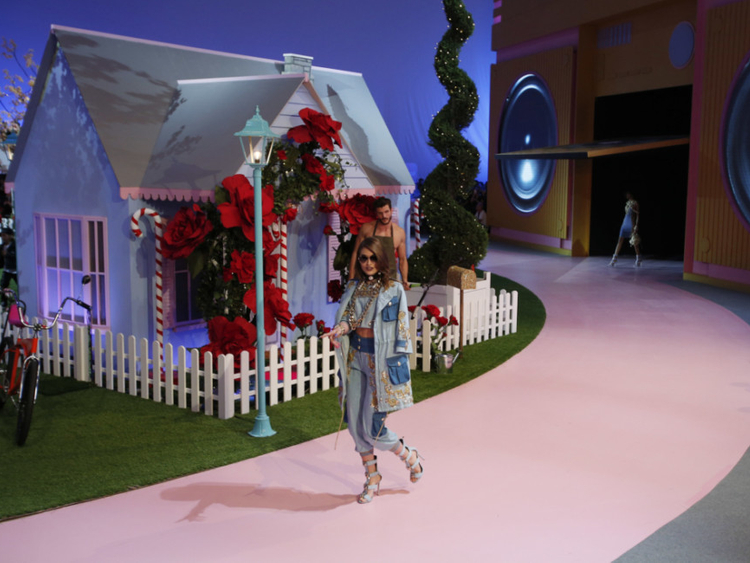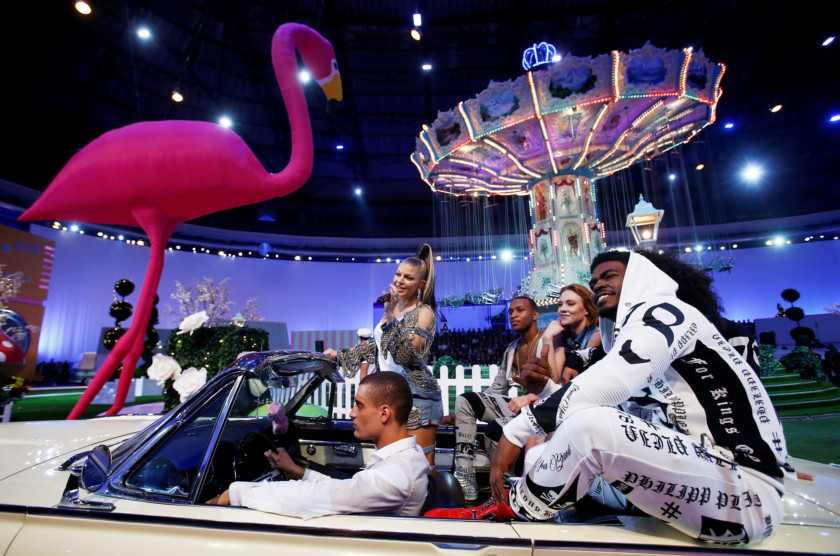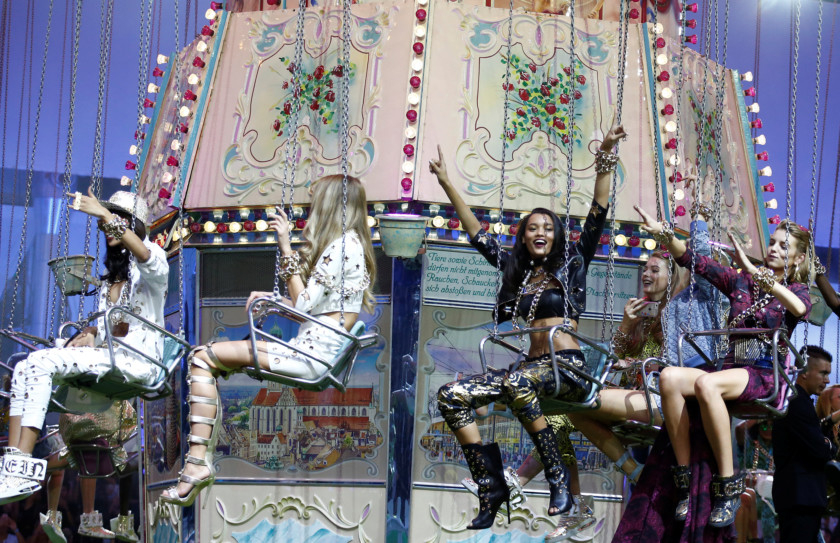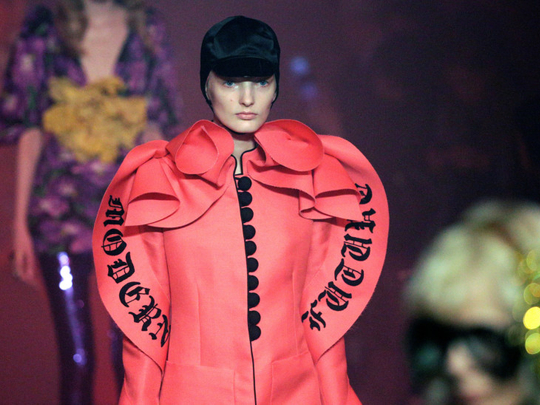
Italian Premier Matteo Renzi was on hand on Wednesday to kick off Milan Fashion Week, putting his political clout behind an industry that sets the standard for the nation, if not the world.
While Italian officials are reducing their economic growth forecasts for the country this year to between 0.8 per cent and 1 per cent, the fashion industry is set to grow by 1.4 per cent and reach a value of 83.6 billion euros (Dh342.35 billion).
This was Renzi’s second time opening fashion week — a sign of the premier’s commitment to helping showcase Italy’s fashion prowess.
The big brands presenting their womenswear collections for next spring and summer in Milan through Monday are motors of that growth. Credit also goes to the supply chain that provides inspiration to designers around the globe.
Gucci, Fausto Puglisi, Roberto Cavalli and Philipp Plein were among the brands showing their wares on the first day of fashion week. Highlights:
GUCCI’S SENSUAL PANIC
Alessandro Michele has cast an eerie, dreamlike spell over Gucci.
The womenswear collection for next spring and summer was presented through a smoky, reddish light — the theatrical equivalent of rose-coloured glasses. All the better for viewing the fantasy-filled collection.
The Gucci girl for next season — the looks require at least a youthful outlook — suggests an antique doll waiting to be dressed up. She can be styled as a Victorian lady, a pretty princess, an athletic boxer or even a denim-clad disco-lover.
The mood veered through eras, but was almost always pretty with a proliferation of ruffles or fringe. Headgear was central, as it is in any dress-up box, and included floppy hats, babushka bandanas and aviator hats.
There also was spectacular, beehive-shaped netting that would be appropriate for tending a queen bee while offering protection from stings.
The designer said all the clothes in the collection “tell a story stepped in wonder, phantasmagoria and unorthodoxy.” He said the experience should provoke, “a sensual panic,” citing French intellectual Roger Callois, and “cultivate the unexpected,” in the words of the German writer Elias Canetti.
Eyewear was big, square and sequinned, attached at the back of the head, and competed for attention with oversized bejewelled earrings.
The lighting flattened the colours, but included bright yellow, green, orange and cotton candy pink. Lurex and sequin accents that would command attention in a crowded nightclub or a foggy alleyway were plentiful.
Michele nudged away from androgyny this season, featuring pretty taffeta dresses with an asymmetrical, off the shoulder cut.
Ruffles of varying doses embellished the dress, while fluffy, fringy flourishes on coat and dress sleeves produced an angelic effect.
“Thank you for giving us dresses,” yelled one admirer backstage in encouragement.
CHIAROSCURO TORMENT
Fausto Puglisi scorned the runway to “celebrate the women who come from hell, who are hell.”
His collection preview was more theatre than fashion show, set against the backdrop of an altar placed behind bars, bedecked with stature of the Virgin Mary, a neon crucifix and ecclesiastical candles. Incense permeated the standing room-only space where the fashion crowd crushed together.
The staging, created by the artistic director of a Tuscan prison theatre company, had the drama of a Caravaggio chiaroscuro, with tormented men becoming the background for an unconventional runway show. For the finale, they beat the bars as if to riot.
The geographic reference was Puglisi’s native Sicily, which he noted had been the victim through history of “a series of devastating and astonishing invasions.”
The looks ranged from counterculture streetwear to pretty day dresses, always with a touch of daring, a dab of risqui. There were print shorts that turned into leggings for a boot effect and worn with stiletto heels accented with accordion trim ruffles.
A floaty floral mini dress, off the shoulder Greek style, had a hint of Roman slave with a thick dark belt and a thick hammered gold necklace. A pretty shift in pink, green and ivory panels challenged convention with a square open back.
Puglisi’s final word: “There is no sin in making our bodies a show.”
ARRIVERDERCI MILANO
So, this is farewell. German designer Philipp Plein pulled out all the stops, yet again, to please the fashion crowd. Pop star Fergie jammed in a vintage convertible. Then so did rapper Fat Joe.
Models in denim, in leather and in animal print leotards, accented by heavy gold chains worn like holsters and thick waist-accenting belts, strode a runway made to look like a 1950s suburban idyll, replete with white houses with picket fences, an oversized pink balloon poodle and a towering garden gnome. Only the word “Pimp” scrawled on the gnome belied the street-smart tone Plein intended when he called the collection, “Alice in Ghettoland.”
A marching band cemented the small-town feel, and the models finished by taking their seats on a carnival swing ride, to be swirled up in the air for the grand finale. All that was missing was pink confetti, which Plein duly supplied.
The crowd was anticipating the usual after-show party, when the designer grabbed a microphone and dropped the news that this would be his last show in Milan, and that the brand is taking its runway party to New York. The disappointment was audible.
He invited the crowd to stay to party, reminding them: “What happens in Ghettoland, stays in Ghettoland.”
Some consolation: Plein isn’t calling it quits altogether in Milan. The designer just opened a 3,000-square-meter showroom for his new luxury activewear brand, Plein Sport, in the centre of the city.
NATIVE AMERICAN SPIRIT
Norwegian designer Peter Dundas explored both his American and his Norwegian roots in a new Roberto Cavalli collection that embody a nomadic spirit.
The Native American dreamcatcher is a repeating motif in the collection that veers from free flowing. It appears as designs on shawls, prints, earrings and is even woven into a knit poncho top that finishes in a long, trailing fringe.
“It started with wanting to explore a little bit my American side. My mother was American,” the designer said backstage. “I discovered Navajo artwork, which reminded me very much of the Norwegian snowflake.”
The wandering didn’t stop there. He took inspiration from Japanese kimonos and French quilting, and mixed it all together. “It was a mental exercise as well,” he said.
Many pieces are stitched out of patchwork, but this is not the prairie version. This patchwork seams together rich gold embossed fabrics in baby-doll tops, sheer lace into evening gowns and contrasting leather, denim and print into trousers.
“It was more like having fun” it was really that. Mixing things and finding things that were surprising to me by collaging elements together,” Dundas said. “It is a summer wardrobe. It means freedom.”
WUNDERKIND AND BLUGIRL DEBUT
Wunderkind, the youthful branch of German designer Wolfgang Joop’s empire, made its Milan debut earlier in the day with a collection featuring long summer, partially transparent dresses over leather bras and transparent plastic trench coats with leather collars and cuffs.
Blugirl, the sexy younger sister of designer Anna Molinari’s main womenswear brand Blumarine, served up a typically irreverent, mix-and-match collection.
Bohemian romanticism was to the fore in the form of 70s-style off-the-shoulder tops with puffball sleeves.
But the look was hardened sometimes with biker boots and sharp fringes helping to create a ‘rock chick’ edge, while a military theme was balanced out by ultra-feminine, delicate touches including frilly neckties.



